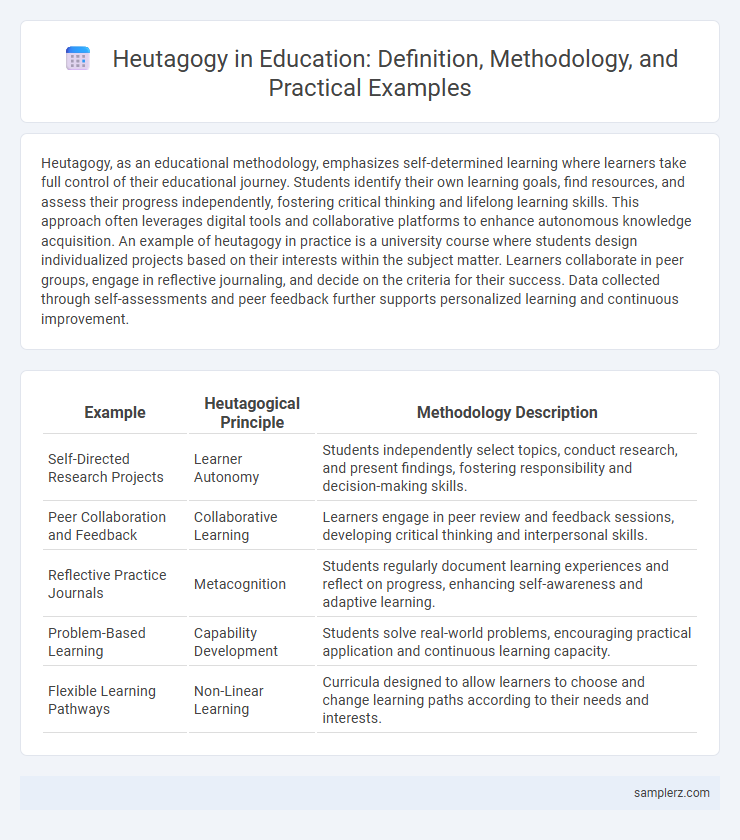Heutagogy, as an educational methodology, emphasizes self-determined learning where learners take full control of their educational journey. Students identify their own learning goals, find resources, and assess their progress independently, fostering critical thinking and lifelong learning skills. This approach often leverages digital tools and collaborative platforms to enhance autonomous knowledge acquisition. An example of heutagogy in practice is a university course where students design individualized projects based on their interests within the subject matter. Learners collaborate in peer groups, engage in reflective journaling, and decide on the criteria for their success. Data collected through self-assessments and peer feedback further supports personalized learning and continuous improvement.
Table of Comparison
| Example | Heutagogical Principle | Methodology Description |
|---|---|---|
| Self-Directed Research Projects | Learner Autonomy | Students independently select topics, conduct research, and present findings, fostering responsibility and decision-making skills. |
| Peer Collaboration and Feedback | Collaborative Learning | Learners engage in peer review and feedback sessions, developing critical thinking and interpersonal skills. |
| Reflective Practice Journals | Metacognition | Students regularly document learning experiences and reflect on progress, enhancing self-awareness and adaptive learning. |
| Problem-Based Learning | Capability Development | Students solve real-world problems, encouraging practical application and continuous learning capacity. |
| Flexible Learning Pathways | Non-Linear Learning | Curricula designed to allow learners to choose and change learning paths according to their needs and interests. |
Understanding Heutagogy in Educational Methodology
Heutagogy emphasizes self-determined learning where learners actively design their educational experiences, fostering autonomy and critical thinking. This methodology integrates real-world problem-solving and reflective practice, enhancing deep understanding and adaptability. Digital tools and collaborative projects often support heutagogical approaches, promoting lifelong learning skills.
Key Principles of Heutagogical Learning Approaches
Heutagogical learning approaches prioritize self-determined learning, where learners actively set their goals and evaluate their progress. Key principles include learner autonomy, capability development, and double-loop learning, enabling individuals to adapt knowledge in diverse contexts. This methodology fosters critical thinking and reflective practice, empowering students to become lifelong, flexible learners.
Self-Determined Learning: Core Concepts and Practices
Heutagogy, or self-determined learning, emphasizes learner autonomy by encouraging students to formulate their own learning goals and actively engage in problem-solving tasks. Key practices include reflective journaling, self-assessment, and collaborative projects that promote metacognition and critical thinking skills. This methodology fosters adaptability and lifelong learning by allowing learners to navigate content relevance and application based on their unique interests and experiences.
Integrating Heutagogy into Classroom Activities
Integrating heutagogy into classroom activities involves promoting self-determined learning where students take ownership of their educational journey by setting goals, identifying resources, and reflecting on their progress. Techniques such as project-based learning, peer teaching, and reflective journaling empower learners to develop critical thinking and adaptability skills essential for lifelong learning. This approach fosters a learner-centered environment that adapts to individual needs and encourages continuous personal and academic growth.
Real-World Projects as Heutagogical Methodology Examples
Real-world projects exemplify heutagogy by emphasizing learner autonomy and self-determined learning, allowing students to apply theoretical knowledge in practical contexts. These projects encourage critical thinking, problem-solving, and reflective practices as learners engage with complex, authentic challenges. By navigating real-world scenarios, students develop meta-cognitive skills essential for lifelong learning and adaptability in dynamic environments.
Collaborative Learning through Heutagogical Methods
Collaborative learning in heutagogical methodology emphasizes learners' autonomy and self-determined knowledge construction through group interactions and shared problem-solving. Techniques such as peer teaching, group discussions, and co-created projects foster critical thinking, metacognitive skills, and adaptability. This approach leverages digital tools and reflective practices to enhance collective engagement and personalized learning pathways.
Technology-Driven Heutagogy in Modern Education
Technology-driven heutagogy in modern education empowers learners to take control of their learning through digital platforms, adaptive learning software, and online collaborative tools. Platforms like MOOCs and interactive simulations enable self-determined learning paths, fostering critical thinking and problem-solving skills. Integration of AI-driven analytics provides personalized feedback, enhancing learner autonomy and engagement.
Assessing Outcomes in Heutagogical Methodologies
Heutagogical methodologies emphasize self-determined learning where learners actively assess their own progress through reflective journals, peer feedback, and digital portfolios. These assessment strategies focus on developing metacognitive skills and lifelong learning capabilities rather than solely standardized testing. This approach aligns with heutagogy's principle of empowering learners to identify their learning goals and measure outcomes based on personal relevance and application.
Supporting Learner Autonomy with Heutagogical Strategies
Heutagogical strategies empower learners to take control of their educational journey by promoting self-determined learning and critical reflection. Techniques such as personalized learning plans, collaborative projects, and problem-based learning encourage autonomy and adaptability in diverse educational settings. These methods align with heutagogy's core principle of cultivating learner capacity to identify resources, set goals, and evaluate progress independently.
Case Studies: Successful Heutagogy Implementation in Education
Case studies reveal successful heutagogy implementation in education through learner-driven projects where students set their own goals and evaluate their progress, enhancing critical thinking and autonomy. For instance, the University of Southern Queensland integrated heutagogical approaches in its engineering programs, resulting in higher student engagement and improved problem-solving skills. These real-world applications demonstrate how self-determined learning fosters adaptive expertise and lifelong learning competencies.

example of heutagogy in methodology Infographic
 samplerz.com
samplerz.com